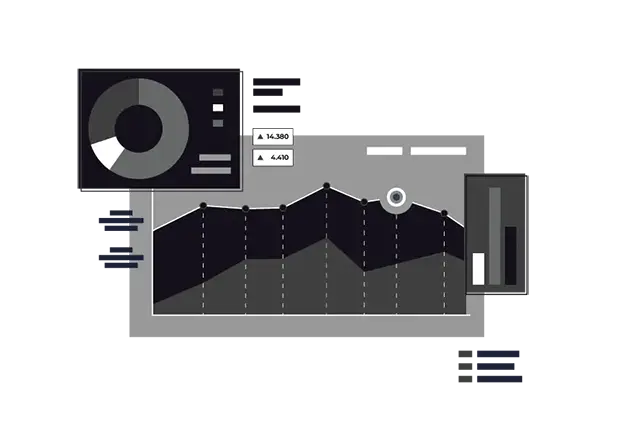

Jupyter Notebook
Jupyter Notebook is an open-source web application that allows users to create and share documents containing live code, equations, visualizations, and narrative text. Widely used in data science, scientific computing, and research, Jupyter Notebook provides an interactive environment where users can combine code execution with data analysis, documentation, and presentation. Originally developed as part of the IPython project, Jupyter has grown into a powerful tool for collaborative research and reproducible science.
Jupyter Notebook
Jupyter Notebook is an open-source web application that allows users to create and share documents containing live code, equations, visualizations, and narrative text. Widely used in data science, scientific computing, and research, Jupyter Notebook provides an interactive environment where users can combine code execution with data analysis, documentation, and presentation. Originally developed as part of the IPython project, Jupyter has grown into a powerful tool for collaborative research and reproducible science.
Mission and Vision
Jupyter's mission is to provide an open, extensible platform that supports interactive computing and empowers users to create, share, and collaborate on computational narratives. Jupyter aims to make computational research more accessible and reproducible by providing tools that integrate coding, analysis, and communication.
The vision of Jupyter is to be the leading platform for interactive computing across all fields of science, education, and data analysis. Jupyter's commitment to open-source development and community collaboration ensures that it evolves with the needs of its users, supporting innovation and the democratization of knowledge.
Key Features and Capabilities
Jupyter Notebook offers a range of features that make it a versatile tool for interactive computing:
 Interactive Code Execution: Jupyter Notebook allows users to run code interactively, cell by cell, enabling immediate feedback and iterative development. Users can write code in various programming languages, including Python, R, Julia, and Scala, making it a flexible tool for multi-language support.
Interactive Code Execution: Jupyter Notebook allows users to run code interactively, cell by cell, enabling immediate feedback and iterative development. Users can write code in various programming languages, including Python, R, Julia, and Scala, making it a flexible tool for multi-language support. Rich Text and Markdown Support: Jupyter Notebook supports Markdown, allowing users to include formatted text, equations, images, and links alongside their code. This feature facilitates the creation of well-documented analyses that combine code, results, and narrative in a single document.
Rich Text and Markdown Support: Jupyter Notebook supports Markdown, allowing users to include formatted text, equations, images, and links alongside their code. This feature facilitates the creation of well-documented analyses that combine code, results, and narrative in a single document. Data Visualization Integration: Jupyter Notebook integrates seamlessly with data visualization libraries such as Matplotlib, Seaborn, and Plotly. Users can create interactive visualizations directly within the notebook, enabling dynamic exploration of data and results.
Data Visualization Integration: Jupyter Notebook integrates seamlessly with data visualization libraries such as Matplotlib, Seaborn, and Plotly. Users can create interactive visualizations directly within the notebook, enabling dynamic exploration of data and results. Extensible with Jupyter Extensions: Jupyter's extensibility allows users to enhance the notebook's functionality with extensions, such as interactive widgets, code formatters, and real-time collaboration tools. These extensions enhance the user experience and expand the capabilities of Jupyter Notebooks.
Extensible with Jupyter Extensions: Jupyter's extensibility allows users to enhance the notebook's functionality with extensions, such as interactive widgets, code formatters, and real-time collaboration tools. These extensions enhance the user experience and expand the capabilities of Jupyter Notebooks. Reproducible Research: Jupyter Notebook's ability to combine code, data, and narrative text in a single document supports reproducible research. Researchers can share notebooks that include all the necessary components to replicate an analysis, enhancing transparency and collaboration.
Reproducible Research: Jupyter Notebook's ability to combine code, data, and narrative text in a single document supports reproducible research. Researchers can share notebooks that include all the necessary components to replicate an analysis, enhancing transparency and collaboration. Interactive Widgets: Jupyter supports interactive widgets that allow users to create user interfaces within their notebooks. These widgets enable users to control parameters, adjust inputs, and visualize changes in real time, making the notebook environment more interactive.
Interactive Widgets: Jupyter supports interactive widgets that allow users to create user interfaces within their notebooks. These widgets enable users to control parameters, adjust inputs, and visualize changes in real time, making the notebook environment more interactive. Version Control and Collaboration: Jupyter Notebook integrates with version control systems like Git, allowing users to track changes, collaborate on projects, and manage code versions. This integration supports team-based research and collaborative development workflows.
Version Control and Collaboration: Jupyter Notebook integrates with version control systems like Git, allowing users to track changes, collaborate on projects, and manage code versions. This integration supports team-based research and collaborative development workflows. Support for Multiple Kernels: Jupyter Notebook can run code in different languages through the use of kernels. This flexibility allows users to work with Python, R, Julia, and other languages within the same environment, making Jupyter a versatile tool for multi-language projects.
Support for Multiple Kernels: Jupyter Notebook can run code in different languages through the use of kernels. This flexibility allows users to work with Python, R, Julia, and other languages within the same environment, making Jupyter a versatile tool for multi-language projects. Cloud Integration: Jupyter Notebooks can be hosted and shared through cloud platforms such as Google Colab, Microsoft Azure, and Binder. These cloud-based environments enable users to collaborate in real time, share analyses with peers, and access computational resources.
Cloud Integration: Jupyter Notebooks can be hosted and shared through cloud platforms such as Google Colab, Microsoft Azure, and Binder. These cloud-based environments enable users to collaborate in real time, share analyses with peers, and access computational resources. Documentation and Tutorials: Jupyter Notebook is supported by extensive documentation and a wide array of tutorials, community forums, and examples. This support network helps users get started quickly, learn new techniques, and troubleshoot issues.
Documentation and Tutorials: Jupyter Notebook is supported by extensive documentation and a wide array of tutorials, community forums, and examples. This support network helps users get started quickly, learn new techniques, and troubleshoot issues.
Applications and Use Cases
Jupyter Notebook is used across various domains, supporting interactive computing, data science, and research:
 Data Science and Machine Learning: Jupyter Notebook is a preferred tool for data scientists due to its ability to integrate data exploration, modeling, and visualization in one environment. Users can experiment with machine learning models, test algorithms, and refine code interactively.
Data Science and Machine Learning: Jupyter Notebook is a preferred tool for data scientists due to its ability to integrate data exploration, modeling, and visualization in one environment. Users can experiment with machine learning models, test algorithms, and refine code interactively. Scientific Research: Jupyter Notebook is widely used in scientific research for data analysis, simulation, and visualization. Researchers use notebooks to document their experiments, share findings, and ensure that their work is reproducible.
Scientific Research: Jupyter Notebook is widely used in scientific research for data analysis, simulation, and visualization. Researchers use notebooks to document their experiments, share findings, and ensure that their work is reproducible. Education and Teaching: In education, Jupyter Notebook is used to teach programming, data analysis, and computational thinking. Its interactive nature engages students, allowing them to run code, explore data, and learn by doing.
Education and Teaching: In education, Jupyter Notebook is used to teach programming, data analysis, and computational thinking. Its interactive nature engages students, allowing them to run code, explore data, and learn by doing. Software Development: Developers use Jupyter Notebooks for prototyping, testing code, and exploring APIs. Its flexibility makes it an ideal environment for experimenting with new ideas and refining code before integrating it into larger projects.
Software Development: Developers use Jupyter Notebooks for prototyping, testing code, and exploring APIs. Its flexibility makes it an ideal environment for experimenting with new ideas and refining code before integrating it into larger projects. Business Analytics and Reporting: Jupyter Notebook is used in business settings for data analysis, reporting, and creating interactive dashboards. Analysts can explore data, generate insights, and present findings in a clear and interactive format.
Business Analytics and Reporting: Jupyter Notebook is used in business settings for data analysis, reporting, and creating interactive dashboards. Analysts can explore data, generate insights, and present findings in a clear and interactive format.
Benefits of Using Jupyter Notebook
Jupyter Notebook offers numerous advantages that make it an essential tool for interactive computing and research:
 Interactive Environment: Jupyter Notebook's interactive nature allows users to run code, view results, and adjust inputs on the fly. This immediacy accelerates the development process and enhances exploratory analysis.
Interactive Environment: Jupyter Notebook's interactive nature allows users to run code, view results, and adjust inputs on the fly. This immediacy accelerates the development process and enhances exploratory analysis. Integrated Documentation: The ability to include Markdown, equations, and narrative text alongside code supports well-documented analyses. This integration fosters transparency and helps users understand the context and methodology behind the results.
Integrated Documentation: The ability to include Markdown, equations, and narrative text alongside code supports well-documented analyses. This integration fosters transparency and helps users understand the context and methodology behind the results. Reproducibility: Jupyter Notebook supports reproducible research by combining code, data, and results in a single document. Researchers can share their entire workflow, ensuring that analyses can be replicated and validated by others.
Reproducibility: Jupyter Notebook supports reproducible research by combining code, data, and results in a single document. Researchers can share their entire workflow, ensuring that analyses can be replicated and validated by others. Flexibility and Extensibility: Jupyter's support for multiple languages and extensibility through plugins and widgets makes it a versatile tool that can adapt to a wide range of applications.
Flexibility and Extensibility: Jupyter's support for multiple languages and extensibility through plugins and widgets makes it a versatile tool that can adapt to a wide range of applications. Visualization and Exploration: Jupyter Notebook's seamless integration with visualization libraries enhances data exploration and communication. Users can create interactive plots that reveal patterns and insights in data.
Visualization and Exploration: Jupyter Notebook's seamless integration with visualization libraries enhances data exploration and communication. Users can create interactive plots that reveal patterns and insights in data. Community and Resources: Jupyter's active community provides extensive resources, including tutorials, templates, and shared notebooks. This support network helps users learn new skills and troubleshoot issues.
Community and Resources: Jupyter's active community provides extensive resources, including tutorials, templates, and shared notebooks. This support network helps users learn new skills and troubleshoot issues.
Promoting Collaboration and Open Science
Jupyter Notebook promotes collaboration and open science through its interactive and shareable nature. Researchers can publish notebooks on platforms like GitHub, Binder, and JupyterHub, allowing others to explore their analyses and build upon their work. This openness fosters a collaborative environment where knowledge is shared, and scientific progress is accelerated.
Impact on Research, Education, and Industry
Jupyter Notebook's impact extends across research, education, and industry, enhancing learning, innovation, and productivity.
 Advancing Research: Jupyter Notebook has revolutionized the way researchers conduct and share their work. Its support for reproducibility and interactivity enhances the quality and transparency of scientific research.
Advancing Research: Jupyter Notebook has revolutionized the way researchers conduct and share their work. Its support for reproducibility and interactivity enhances the quality and transparency of scientific research. Enhancing Education: In education, Jupyter Notebook engages students with hands-on learning experiences. Its interactive format allows learners to experiment with code, explore data, and develop a deeper understanding of computational concepts.
Enhancing Education: In education, Jupyter Notebook engages students with hands-on learning experiences. Its interactive format allows learners to experiment with code, explore data, and develop a deeper understanding of computational concepts. Driving Business Innovation: In industry, Jupyter Notebook supports data-driven decision-making by providing a flexible platform for analyzing data and communicating insights. Its integration with data visualization and machine learning tools helps businesses explore new opportunities and optimize performance.
Driving Business Innovation: In industry, Jupyter Notebook supports data-driven decision-making by providing a flexible platform for analyzing data and communicating insights. Its integration with data visualization and machine learning tools helps businesses explore new opportunities and optimize performance.
Conclusion
Jupyter Notebook is a powerful tool that combines coding, analysis, and communication in an interactive environment. Its versatility, ease of use, and support for multiple languages make it an invaluable resource for data scientists, researchers, educators, and developers. By enabling reproducible research, fostering collaboration, and enhancing data exploration, Jupyter Notebook continues to transform the way we interact with data, driving innovation and discovery across disciplines.
Resource Library
Partnered Content Networks
© 2024 STEM Network. All rights reserved.





























